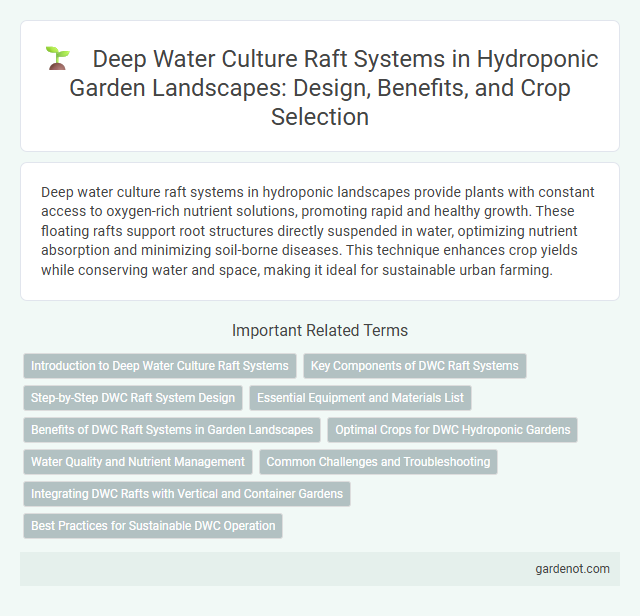Deep water culture raft systems in hydroponic landscapes provide plants with constant access to oxygen-rich nutrient solutions, promoting rapid and healthy growth. These floating rafts support root structures directly suspended in water, optimizing nutrient absorption and minimizing soil-borne diseases. This technique enhances crop yields while conserving water and space, making it ideal for sustainable urban farming.
Introduction to Deep Water Culture Raft Systems
Deep Water Culture (DWC) Raft Systems are an efficient hydroponic technique where plant roots are suspended in oxygen-rich nutrient solutions supported by floating rafts. This method promotes rapid growth by ensuring continuous access to water, nutrients, and oxygen, making it ideal for leafy greens and herbs. DWC rafts simplify system maintenance while maximizing yield through improved root aeration and nutrient uptake.
Key Components of DWC Raft Systems
Deep water culture (DWC) raft systems consist of essential components such as buoyant rafts, net pots, and aeration devices that maintain optimal oxygen levels in nutrient-rich water. The rafts support plants while allowing roots to dangle directly into the oxygenated solution, promoting efficient nutrient uptake. High-quality air pumps and diffusers ensure continuous oxygen circulation, enhancing root health and overall plant growth in hydroponic landscapes.
Step-by-Step DWC Raft System Design
The Deep Water Culture (DWC) raft system features a floating platform that supports plants while their roots remain submerged in oxygen-rich, nutrient-infused water, enhancing growth rates and yield. Key design steps include selecting an appropriate reservoir size based on crop type, ensuring effective aeration with air stones and pumps to maintain optimal dissolved oxygen levels, and constructing a sturdy raft with net pots to securely hold and space plants for maximum light exposure. Monitoring pH and nutrient concentration regularly guarantees the ideal hydroponic environment essential for healthy plant development.
Essential Equipment and Materials List
Deep water culture (DWC) raft systems require essential equipment such as buoyant rafts, net pots, and an air pump with air stones to maintain oxygenated nutrient solution. Nutrient-rich water reservoirs, water pumps for circulation, and grow media like clay pellets or rockwool support root stability and promote healthy plant growth. Reliable pH and EC meters are also crucial for monitoring water quality and ensuring optimal nutrient uptake in hydroponic landscapes.
Benefits of DWC Raft Systems in Garden Landscapes
Deep Water Culture (DWC) raft systems enhance garden landscapes by delivering consistent oxygenated nutrient supply directly to plant roots, promoting faster growth and higher yields. These systems reduce water usage by recycling nutrient solutions, making them an eco-friendly choice for sustainable gardening. The floating raft design optimizes space, allowing for dense plant arrangement and efficient use of garden areas.
Optimal Crops for DWC Hydroponic Gardens
Lettuce, spinach, and herbs such as basil and mint thrive in Deep Water Culture (DWC) hydroponic gardens due to their fast growth and shallow root systems. These crops benefit from continuous oxygenation and nutrient availability in the nutrient-rich solution held by the rafts. Leafy greens and certain fruiting plants like strawberries achieve optimal yields and quality in DWC systems, making them ideal for hydroponic landscapes.
Water Quality and Nutrient Management
Maintaining optimal water quality in Deep Water Culture (DWC) raft systems is critical for plant health and nutrient uptake efficiency. Key parameters including pH levels between 5.5 and 6.5, electrical conductivity (EC) within 1.2 to 2.0 mS/cm, and dissolved oxygen concentrations above 6 mg/L ensure balanced nutrient availability and prevent root diseases. Precise nutrient management involves continuous monitoring and adjustment of macronutrients like nitrogen, phosphorus, and potassium to promote vigorous growth and maximize yield in hydroponic landscapes.
Common Challenges and Troubleshooting
Deep Water Culture (DWC) raft systems often face oxygen depletion, root rot, and nutrient imbalances, impacting plant growth and health. Maintaining proper dissolved oxygen levels above 6 mg/L and regularly monitoring pH between 5.5 and 6.5 can prevent these common issues. Installing air stones and ensuring consistent water circulation optimize root oxygenation and nutrient uptake, reducing the risk of system failures.
Integrating DWC Rafts with Vertical and Container Gardens
Integrating Deep Water Culture (DWC) rafts with vertical and container gardens enhances space utilization and nutrient delivery efficiency in hydroponic landscapes. Combining DWC rafts allows continuous nutrient-rich water circulation, promoting root oxygenation and rapid plant growth in vertical setups and confined container spaces. This synergy maximizes yield per square foot while maintaining optimal plant health through controlled water and nutrient management.
Best Practices for Sustainable DWC Operation
Maintaining optimal oxygen levels in Deep Water Culture (DWC) rafts enhances root health and nutrient uptake, critical for sustainable operation. Regular monitoring of pH and nutrient concentration ensures balanced growth while preventing toxic buildup and nutrient deficiencies. Integrating efficient water recirculation systems reduces water waste and supports eco-friendly hydroponic landscape management.
Deep water culture raft Infographic

 gardenot.com
gardenot.com